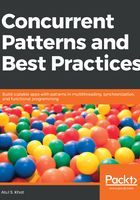
Parallel collections
Say that I am describing some new and exciting algorithm to you. I start telling you about how the algorithm exploits hash tables. We typically think of such data structures as all residing in memory, locked (if required), and worked upon by one thread.
For example, take a list of numbers. Say that we want to sum all these numbers. This operation could be parallelized on multiple cores by using threads.
Now, we need to stay away from explicit locking. An abstraction that works concurrently on our list would be nice. It would split the list, run the function on each sublist, and collate the result in the end, as shown in the following diagram. This is the typical MapReduce paradigm in action:

The preceding diagram shows a Scala collection that has been parallelized in order to use concurrency internally.
What if the data structure is so large that it cannot all fit in the memory of a single machine? We could split the collection across a cluster of machines instead.
The Apache Spark framework does this for us. Spark's Resilient Distributed Dataset (RDD) is a partitioned collection that spreads the data structure across cluster machines, and thus can work on huge collections, typically to perform analytical processing.